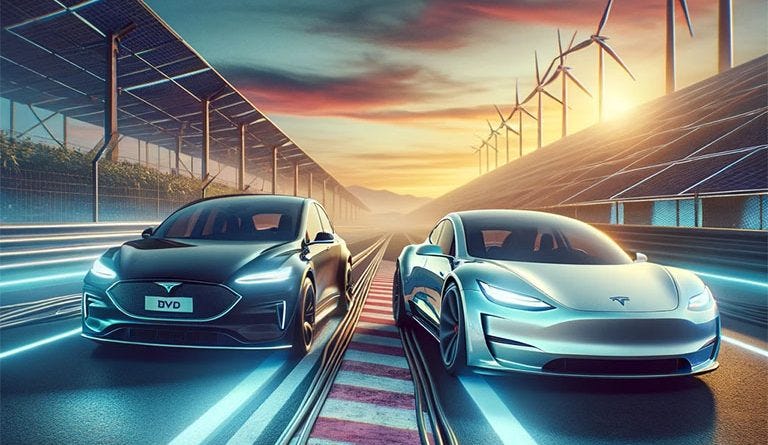From Scale to Strength: Can BYD Win in 2025?
BYD in 2025: Strategic Priorities Amid a Reshaped EV Landscape
Things that caught our attention
Things that caught our attention
Introduction
In 2025, BYD is everywhere: topping EV sales charts, beating Tesla (at least in China), and making headlines with its rapid global expansion. But beneath the surface of impressive growth lies a more complicated story—one of rising inventory, squeezed margins, and an ambitious, not-yet-proven attempt to go premium.
How does a company known for “value-for-money” vehicles reposition itself as a global mobility powerhouse? Can vertical integration alone defend profitability in an increasingly spec-sensitive, brand-driven market? And what happens when local price wars meet European tariffs?
In the free portion of this piece, we walk you through BYD’s Q1 2025 performance, its aggressive pricing tactics, and how it’s weathering the aftershocks of China’s subsidy exit. We also look at early signs of brand fatigue and inventory stress.
Behind the paywall, we go deeper:
Is BYD’s smart driving rollout a breakthrough or just a cost trap?
What’s really happening in its climb upmarket—are Denza, Fang Cheng Bao, and Yangwang gaining traction or just burning cash?
And is BYD’s overseas expansion a second growth curve or a profit mirage?
Let’s unpack what may be BYD’s most critical transformation year yet.
Yours sincerely,
Rita Luan, Tech Research Analyst
From Underdog to Contender
In a 2011 Bloomberg TV interview, Elon Musk dismissed BYD as a serious competitor: “Have you seen their car? They have very low cost, and their technology is not very good... They’ve had a lot of problems in their home market.” Over a decade later, when the clip resurfaced in May 2023, Musk acknowledged the shift: “That was many years ago. Their cars are highly competitive these days.” His change in tone reflects not only the rapid ascent of China’s EV sector, but also BYD’s pivot from volume-driven manufacturing to long-term value creation and brand development.
Recent performance underscores this transition. In Q1 2025, BYD’s global wholesale volume reached 1,000,800 units, up 59.8% year-over-year. Tesla, by comparison, delivered 336,681 vehicles globally—a 13% decline (Note: BYD reports wholesale shipments, not end-user deliveries). In China, BYD sold 416,400 battery electric vehicles (BEVs), far exceeding Tesla’s 137,200 units.
This growth fueled strong financial results. BYD reported Q1 revenue of 170.4 billion RMB (USD 23.5 billion), up 36.4% year-over-year, with net profit doubling to 9.2 billion RMB (around USD 1.3 billion). Net margin rose from 3.8% to 5.5%. However, expansion brought capital strain: inventory reached 154.4 billion RMB (USD 21.3 billion)—accounting for 18.4% of total assets—and turnover days approached 80.
At BYD’s June 2025 shareholder meeting, Chairman Wang Chuanfu reiterated a commitment to long-termism: “We won’t disparage competitors or engage in price wars... This is BYD’s principle.” He set a base sales target of 5 million units for 2025, with an aspirational goal of 5.5 million and exports of 800,000 to 1 million. To support this, BYD is ramping up CKD plant construction in Hungary, Turkey, Thailand, and Brazil, and leveraging its roll-on/roll-off shipping fleet to improve logistics and offset tariffs.
We observe that BYD faces three de facto strategic priorities in 2025:
The domestic 200,000–300,000 RMB segment, where Geely’s Galaxy M9 has raised the bar with lidar and a 1,500 km range. BYD must fine-tune the cost-to-spec ratio in an increasingly spec-sensitive market.
The premium market above 500,000 RMB, where Denza accounts for under 5% of total sales. Strengthening brand perception is key to boosting average selling prices and gross margins.
Global expansion, as external pressures mount. The EU will impose a 17.4% countervailing duty on Chinese BEVs starting July 2025. BYD’s Hungary plant, slated for year-end production, and its shipping fleet are core to its localization and margin-preservation strategy.
On the technology side, BYD introduced 21 models in February 2025 featuring its in-house “Divine Eye” ADAS system, targeting 50% penetration among core models by midyear. The aim: to build product differentiation across pricing tiers through accessible smart driving. As of March, adoption had reached 35% in high-end models and 15–20% in mid-to-low tier vehicles. Given this trajectory and ongoing model refreshes, BYD appears on track to meet or approach the 50% penetration target by the end of Q2 or shortly thereafter. The pace of rollout will depend on production cycles, software optimization, and consumer reception in lower price segments.
Strategically, BYD’s methodical scaling contrasts with Tesla’s fast-paced iteration. While Musk favors speed and disruption, Wang is doubling down on vertical integration and operational depth. Whether endurance or agility defines the next phase of EV leadership remains an open question.
Price War
In late 2022, the Chinese government officially ended the national new energy vehicle (NEV) purchase subsidy program, a policy that had been in place for 13 years. The removal of this financial support marked a pivotal moment for the industry. With subsidies no longer cushioning costs, automakers faced immediate margin pressure, and market competition entered a new phase—one driven by cost efficiency and strategic pricing rather than policy tailwinds.
Tesla was the first to act. In early 2023, the company initiated aggressive price cuts in China, driven by a confluence of operational and market concerns: underwhelming Q4 2022 global deliveries, rising local inventory, overcapacity at its Shanghai Gigafactory, and growing investor skepticism about forward sales momentum. In January 2023, Tesla reduced the price of its core models in China—slashing 20,000 to 48,000 RMB (USD 2,760 to USD 6,620) off the Model 3 and Model Y. This brought the Model 3’s entry price to 229,900 RMB (USD 31,720) and the Model Y’s to 259,900 RMB (USD 35,850). The company doubled down in April 2024, cutting prices by another 10,000+ RMB (USD 1,380+) across the lineup.
Tesla’s price cuts reverberated throughout the domestic NEV market, forcing rivals to follow. What began as a promotional tactic quickly escalated into a sector-wide price war, compressing margins and intensifying competition.
Inventory vs. Profit
As the dominant player in China’s NEV market, BYD was not immune to the pressures. In 2024, it responded with its own price-cutting campaign. A flagship move came with the launch of the Qin PLUS Glory Edition, whose price dropped from 99,800 RMB (USD 13,770) to 79,800 RMB (USD 11,010)—a clear signal that BYD was ready to defend market share in the entry-level segment.
However, as the price war deepened, BYD appeared to reach a strategic inflection point. The company began to signal, both through product strategy and public remarks, that scale alone would not be sufficient to sustain competitive advantage. In an increasingly crowded and spec-driven market, BYD recognized that long-term competitiveness would need to come from a more robust value proposition: one built on product differentiation, brand equity, and proprietary technology.
Despite heightened market competition, BYD retained a commanding presence in the mainstream 100,000–200,000 RMB (USD 13,800–27,600) price range throughout 2024, thanks largely to its vertically integrated supply chain. The company captured roughly 50% market share in this segment and 25% in the sub-100,000 RMB (USD 13,800) bracket. Models like the Yuan PLUS, Song Pro DM-i, and Seal 05 EV maintained strong sales momentum.
But starting in 2025, the market structure has shifted. New entrants such as Geely Galaxy, Changan Deep Blue, and Leapmotor have accelerated their rollout of competitively priced models. Geely’s Galaxy E5 Intelligent Driving Edition, priced at 106,000 RMB (USD 14,600), undercuts BYD’s Yuan PLUS counterpart by approximately 4,000 RMB (USD 550), pressuring BYD’s share in the 100,000–150,000 RMB (USD 13,800–20,700) range. Meanwhile, Leapmotor’s B10, priced at 99,800 RMB (USD 13,770), is directly targeting the Qin PLUS and has already surpassed 10,000 units in monthly sales. As of April 2025, BYD’s cumulative sales reached 1.38 million units—just under 25% of its 5.5 million annual sales target—suggesting rising execution pressure.
This intensifying competition has worsened BYD’s inventory position. By Q1 2025, inventory had reached 154.4 billion RMB (USD 21.3 billion), up 38.4 billion RMB (USD 5.3 billion) from the end of 2024. Turnover days rose to 70–80, significantly above the industry norm of 30–45 days, resulting in increased capital lock-up. At the same time, price competition has eroded profitability: gross margin dropped from 22% in 2024 to around 20% in early 2025, with certain key models falling to 14–16%. Management has set 20% as a bottom-line threshold, but maintaining that line is proving difficult under current conditions.
In June 2025, BYD reportedly suspended night shifts and postponed capacity expansion at several factories in China, citing rising inventory and subdued market demand. This production scale-back reflects growing execution pressure amid intensifying price competition and overcapacity concerns.






